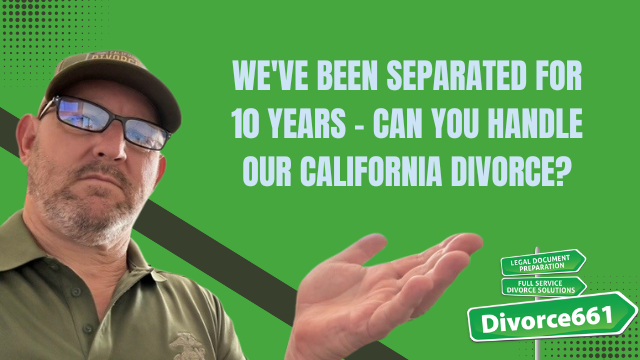Step-by-Step Guide to an Amicable Divorce in Contra Costa
Hi, I’m Tim Blankenship with Divorce661. If you and your spouse have decided to part ways peacefully, an amicable divorce is the smartest and smoothest path forward. In this guide I’ll walk you through the exact steps to complete an amicable divorce in Contra Costa County—quickly, correctly, and without unnecessary court appearances or drama.
“If you and your spouse have decided to part ways peacefully, an amicable divorce is the smartest and smoothest path forward.”
Why an amicable divorce in Contra Costa?
An amicable divorce keeps costs down, reduces stress, and lets you control the outcome. Contra Costa County supports full e-filing and simple procedures for couples who agree on the terms, which makes it possible to move through the paperwork efficiently without attorneys or court hearings when both parties cooperate.
Overview: the five core steps
- File the initial paperwork
- Serve your spouse (or obtain acknowledgement of service)
- Complete and exchange financial disclosures
- Create and sign a Marital Settlement Agreement
- Submit your final judgment package to the court
Step 1 — Filing your initial paperwork
Start by preparing the Petition and Summons. If you have minor children, include the UCCJEA (Uniform Child Custody Jurisdiction and Enforcement Act) form. In Contra Costa County these documents are submitted through the court’s e-filing system. Once the court accepts your packet, you’ll receive a case number.
- What to file: Petition, Summons, UCCJEA (if children are involved), and any required local forms.
- How to file: Use Contra Costa’s e-filing portal to submit documents electronically.
- Result: The court issues a case number and records your case.
Step 2 — Serving your spouse
After filing, the other spouse must be officially served with the filed documents. If your spouse is cooperative, they can sign a Notice of Acknowledgement to avoid formal personal service. This step is important because it starts the statutory six-month waiting period required under California law before a divorce can be finalized.
- Cooperative option: Acknowledgement of Service (signed by your spouse).
- Formal option: Personal service by a third-party process server or sheriff.
- Timing: Service triggers the six-month waiting clock.
Step 3 — Financial disclosures (mandatory)
Even in an amicable case, both parties must fully disclose financial information. Transparency is required so the court can ensure any agreement is informed and fair.
- Common disclosures: income, monthly expenses, assets, debts, retirement accounts, bank accounts, and property.
- Documents to gather: pay stubs, tax returns, account statements, mortgage statements, and debt statements.
- Tip: Be thorough—failure to disclose can void an agreement later or lead to court intervention.
Step 4 — Drafting the Marital Settlement Agreement
Work together to create a written Marital Settlement Agreement (MSA). This document spells out how you will divide property, handle spousal support (if any), and address custody, visitation, and child support when children are involved.
- What to include: clear division of assets and debts, spousal support terms, a parenting plan, and child support calculations if applicable.
- Make it specific: list assets individually, include account numbers or descriptions, and set timelines for transfers or refinances.
- Signing: Both parties must sign the agreement before submitting it as part of the final package.
Step 5 — Submitting your final judgment package
When your agreement is signed and disclosures are exchanged, assemble your final judgment packet for the court. This package typically contains the signed Marital Settlement Agreement, necessary final judgment forms, proofs of service or acknowledgements, and confirmations that disclosure requirements were met.
- File the packet via e-filing to the Contra Costa clerk’s office.
- The court will review and, if everything is in order, approve the judgment.
- Important: California law requires that the divorce not be finalized until on or after the six-month waiting period from the date of service.
Real example and timing note
We recently helped a fully cooperative couple in Contra Costa complete their paperwork and receive approval from the court’s clerks in under five weeks—their forms were accepted without any rejections because everything was prepared and filed correctly. Keep in mind, however, that the statutory waiting period still governs the earliest date a divorce can be finalized; clerks can accept filings quickly, but the final judgment must comply with applicable timing rules.
Common mistakes to avoid
- Incomplete or inaccurate financial disclosures
- Unsigned or ambiguous settlement agreements
- Failing to file UCCJEA when children are involved
- Incorrect service or missing proof of service
- Improper e-filing format or missing local forms
How Divorce661 helps
At Divorce661 we specialize in amicable divorces in Contra Costa County. We guide couples through every step so you can avoid mistakes, delays, and unnecessary court appearances.
- We prepare and review all necessary forms and disclosures
- We file your paperwork via the court’s e-filing system
- Flat-fee pricing—no hourly surprises
- 100% remote support across Contra Costa County
- Free consultation to review your situation and the required steps
Ready to move forward?
If you’re ready to complete your divorce peacefully and professionally in Contra Costa County, visit Divorce661.com to schedule a free consultation. We’ll handle the process from start to finish and help you move forward with confidence.
Final thoughts
An amicable divorce can save time, money, and stress—but it still requires careful attention to procedure and disclosure. Follow the five steps outlined here, avoid common pitfalls, and get professional guidance when you need it. Done right, an amicable divorce lets both parties close one chapter and begin the next with clarity and dignity.










